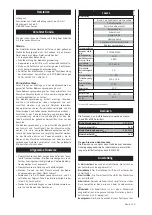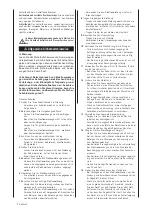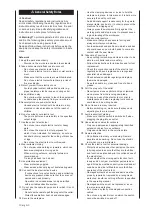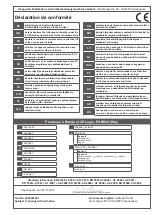
english 11
21
ATTENTION!
–
The use of other insertion tools and other acces-
sories can entail a risk of injury.
22
Have your electric tool repaired by a qualified
electrician
–
This electric tool conforms to the applicable safe-
ty regulations. Repairs may only be performed by
an electrician using original spare parts. Other-
wise accidents can occur.
Additional safety rules for the belt and disc sanding machine
•
WARNING:
Do not use your machine until it is completely
assembled and installed according to the instructions.
• If you are not familiar with the operation of the sanding
machine, ask the head of the department, your teacher,
or any other qualified person.
•
ATTENTION:
This machine has only been designed for
sanding wood or similar materials. The sanding of other
materials can cause fire, injuries, or damage the prod-
uct.
• Always wear safety goggles.
• This machine may only be operated indoors.
•
IMPORTANT:
Mount and use the machine on a horizontal
surface. A non-horizontal surface can damage the motor.
• If the machine tends to tilt or walk (especially when
sanding long and heavy panels), it must be fastened to a
solid surface of sufficient carrying force.
• Make sure the sanding belt runs in the correct direction
– see arrows at the back of the belt.
• Make sure the sanding belt is running correctly so that it
cannot come off the drive pulleys.
• Make sure the sanding belt is not twisted or loose.
• Firmly hold the workpiece when sanding.
• Always use the fence when using the sanding machine
in horizontal position.
• Always hold the workpiece firmly to the table when using
the sanding disc.
• Always hold the workpiece to the side of the sanding
disc running downwards, in order to maintain the work-
piece pressed to the table. By using the upward-running
side of the sanding disc, the workpiece could be ejected
and cause injury to persons.
• Always keep a minimum distance of about 1.5 mm or
less between the table or fence and the sanding belt or
disc.
• Do not wear gloves. Do not hold the workpiece with a
cloth during sanding.
• Use sanding belt or disc of the correct grit corresponding
with the wood.
• Never sand workpieces too small to be held safely.
• Avoid awkward hand positions where a sudden slip could
cause your hand to touch the sanding belt or disc.
• When sanding a large piece of material, provide an ad-
ditional support at table height.
• Never sand an unsupported workpiece. Secure the work-
piece with the table or the fence. Exceptions are the
sanding of curved workpieces on the outside of the sand-
ing disc.
• Always clear the table, fence or sanding belt of scraps or
other objects, before turning the machine on.
• Do not perform any layout assembly or set-up work on
the table while the sanding machine is in operation.
• Switch the machine off and pull the power plug from the
socket when fitting or removing accessories.
• Never leave the working area of the sanding machine
while the tool is running, or as long as it has not come to
an absolute standstill.
m
Proper Use
The machine meets the currently valid EU machine directive.
• The manufacturer’s safety, operation and maintenance
instructions as well as the technical data given in the
calibrations and dimensions must be adhered to.
• Relevant accident prevention regulations and other gen-
erally recognized safety and technical rules must also be
adhered to.
• The machine may only be used, maintained or repaired
by trained persons who are familiar with the machine
and have been informed about the dangers. Unauthor-
ized modifications of the machine exclude a liability of
the manufacturer for damages resulting from the modifi-
cations.
• The machine is intended for use only with original spare
parts and original tools from the producer.
• Any other use is considered to be not intended. The
manufacturer excludes any liability for resulting dam-
ages, the risk is exclusively borne by the user.
Please note that our equipment has not been designed
for use in commercial, trade or industrial applications.
Our warranty will be voided if the equipment is used
in commercial, trade or industrial businesses or for
equivalent purposes.
m
Remaining hazards
The machine has been built using modern technology and
in accordance with recognized safety rules.
Some hazards, however, may still remain.
• The grinding wheel poses a danger of injury to fingers
and hands by improper feeding or placement of tools.
• Danger of injury from thrown tools due to improper hold-
ing or feeding.
• The use of incorrect or damaged mains cables can lead
to electrical injuries.
• Although having regarded all considerable rules there
may still remain not obvious remaining hazrds.
• Minimize remaining hazards by following the instruc-
tions in ”Safety Rules”, ”Use only as authorized” and in
the entire operating manual.
Commissioning
Installing sanding disc and disc guard, Fig. 4
WARNING:
Do not connect to power supply until assembly
is complete. Failure to comply could result in accidental
starting and possible serious injury.
• Align perimeter of sanding disc with plate and press
firmly into position.
• Position disc guard against the lower one-third of the
disc, aligning holes as shown in figure 4.
• Using the two phillips head screws, securely tighten the
disc guard into place.
Installing/Replacing sanding belt, Fig. 5.
On the smooth side of the sanding belt, there is a direc-
tional arrow. The sanding belt must run in the direction of
the arrow.
• Pull the tension lever toward you to release belt tension.
• Place the sanding belt over the drive drum and idler drum
with the directional arrows running counterclockwise. Be
sure the sanding belt is centered on both drums.
• Push the tension lever back into place to apply the belt













































